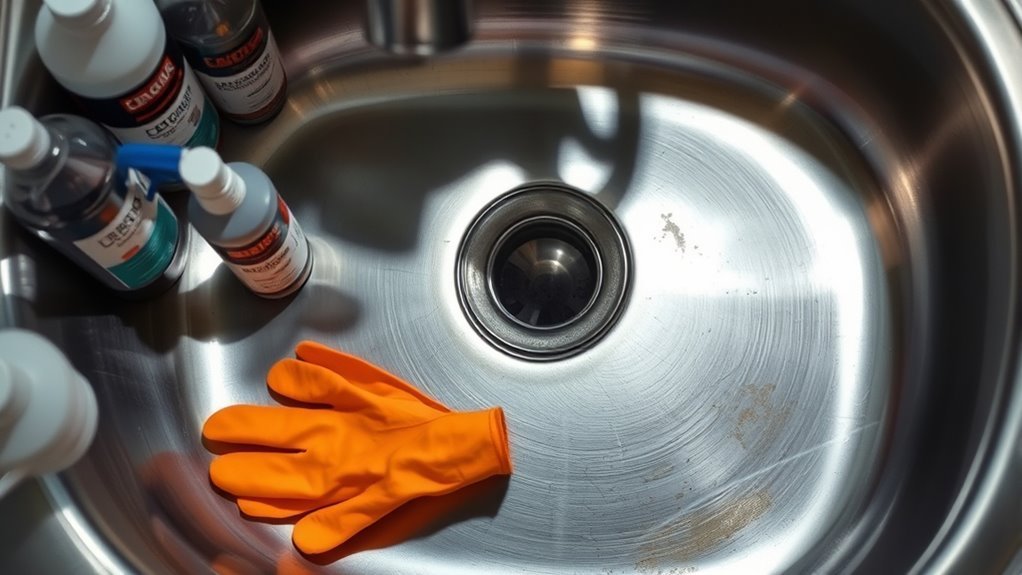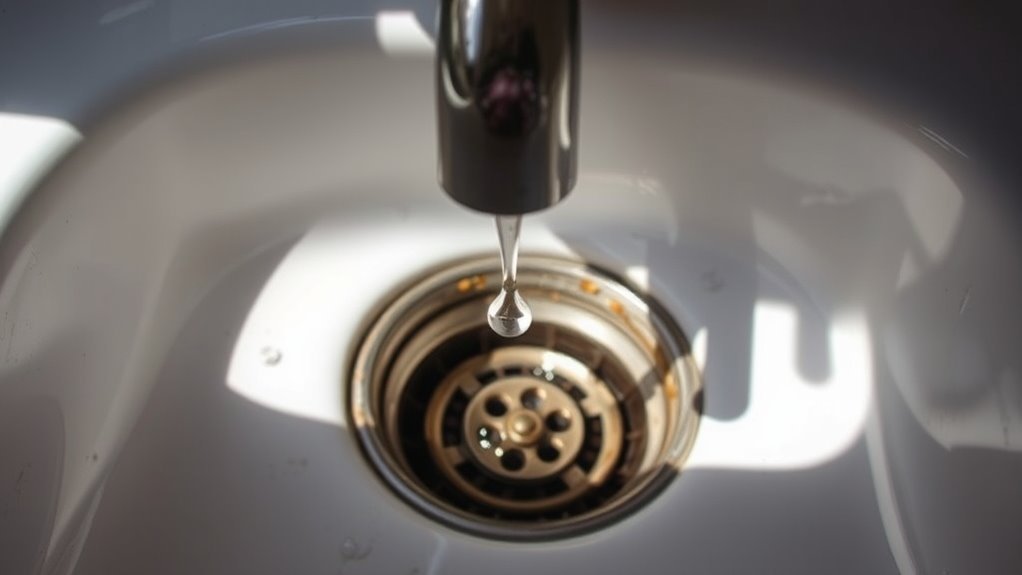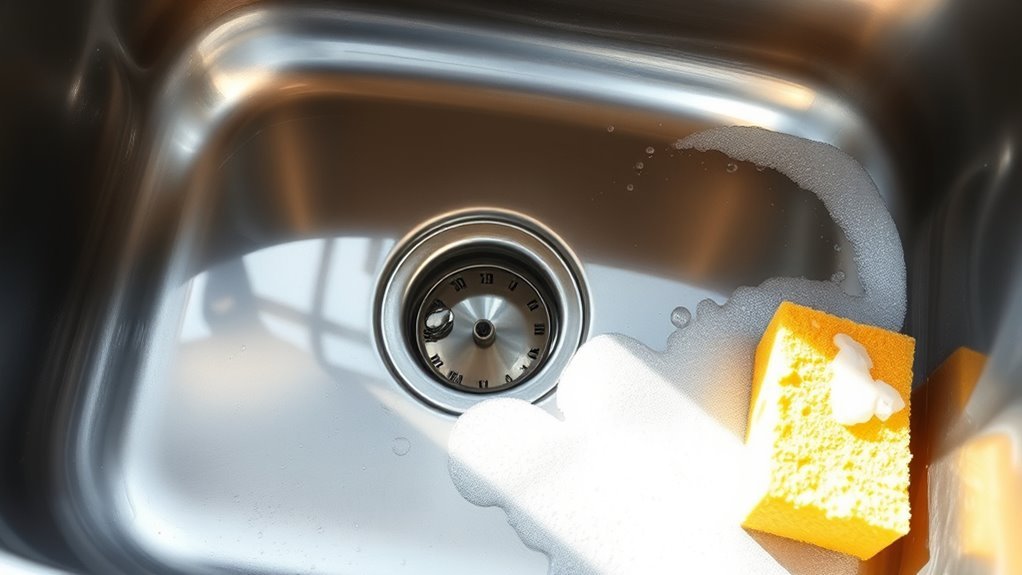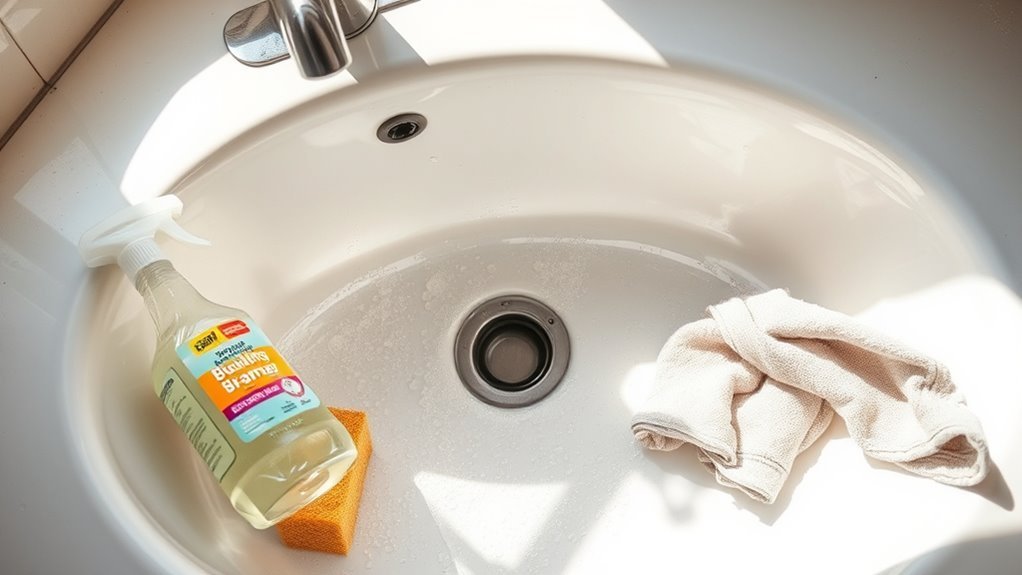Common Mistakes When Cleaning Sink
You might be damaging your sink by using harsh chemicals or abrasive scrubbers that scratch and erode surfaces. Skipping regular cleaning allows grime, bacteria, and mineral deposits to build up, causing clogs and odors. Neglecting the drain, faucet areas, and strainer invites bacteria growth and reduces appliance lifespan. Leaving standing water or soap scum fosters mold, while forgetting to dry your sink leads to water spots. Choosing the wrong tools can shorten its life. Keep these tips in mind to enhance your sink’s durability and cleanliness.
Using Harsh Chemicals That Damage Sink Surfaces

Although harsh chemicals might seem effective for cleaning your sink, they can actually cause significant damage to its surface over time. Using these substances often erodes finishes, leading to discoloration and scratches that compromise your sink’s look and durability. To maintain surface protection, you should opt for chemical alternatives like baking soda, vinegar, or gentle, non-abrasive cleaners specifically designed for your sink material. These options not only clean effectively but also preserve the integrity of the surface, ensuring long-lasting beauty and function. By choosing safer methods, you gain freedom from constant repairs or replacements caused by harsh chemicals. Protect your sink’s surface by embracing smarter cleaning solutions that work with your sink, not against it. Regularly rinsing your sink with warm water after use also helps prevent damage and buildup, promoting daily maintenance routines.
Ignoring Regular Cleaning Schedules
You can’t skip daily wipes without letting grime build up and cause stains or odors. Neglecting regular deep cleans allows bacteria and buildup to accumulate in hard-to-reach spots. Staying consistent with your cleaning schedule is key to keeping your sink spotless and hygienic. Rinsing the sink after each use is an effective way to prevent buildup and maintain freshness between cleanings.
Skipping Daily Wipes
Frequently skipping daily wipes can quickly lead to stubborn stains and buildup in your sink. It’s easy to underestimate the impact of small, consistent efforts, but incorporating simple daily routines can make a significant difference. By wiping down your sink after each use, you prevent residue and grime from settling, saving you time and effort later. Effective habits like these keep your sink fresh and reduce the need for harsh chemicals or intense scrubbing. You want your cleaning process to feel liberating, not burdensome—daily maintenance empowers you to enjoy a clean sink effortlessly. Don’t let neglect turn a manageable task into a chore. Stick to daily wipes, and you’ll maintain a spotless sink with minimal effort and maximum freedom.
Overlooking Deep Cleans
Keeping up with daily wipes lays a solid foundation, but neglecting deeper cleans can still leave your sink vulnerable to hidden grime and buildup. You need to schedule regular deep cleaning techniques to tackle those overlooked areas like drain edges, faucet bases, and the sink’s underside. These spots accumulate dirt and bacteria, compromising your sink’s hygiene and appearance. Here’s a simple guide to what you should target:
| Overlooked Areas | Cleaning Tools | Frequency |
|---|---|---|
| Faucet Base | Toothbrush, Vinegar | Weekly |
| Drain Edges | Baking Soda, Brush | Biweekly |
| Sink Underside | Disinfectant Spray | Monthly |
Neglecting to Clean the Drain and Faucet Areas

Although the sink basin often gets your attention, the drain and faucet areas are just as prone to grime and buildup. Neglecting these spots compromises drain maintenance and faucet hygiene, fostering bacteria and unpleasant odors. To keep your sink truly clean, focus on these key points:
- Regularly remove debris from the drain to prevent clogs and maintain smooth water flow.
- Disinfect faucet handles and spouts to stop germs from spreading.
- Use a soft brush to clean around the faucet base, where grime tends to accumulate unnoticed.
- Check for mineral deposits and wipe them away to maintain faucet functionality and appearance. Incorporating eco-friendly cleaning products when disinfecting these areas helps protect your plumbing and the environment.
Scrubbing With Abrasive Materials
Once you’ve tackled the drain and faucet areas, it’s important to contemplate how you clean the sink surface itself. Scrubbing with abrasive materials might seem effective, but it can seriously damage your sink surfaces. These harsh scrubbing tools can scratch, dull, or wear away protective coatings, leaving your sink vulnerable to stains and corrosion. Instead, opt for soft sponges or microfiber cloths that clean thoroughly without harming the finish. If you need extra cleaning power, choose non-abrasive cleaners designed for your sink material. Remember, preserving the integrity of your sink surfaces means less maintenance and longer-lasting appeal. Avoid the temptation to scrub aggressively with abrasive materials—you want your sink looking fresh, not scratched or worn down. Your sink deserves care that sets you free from constant repairs. Additionally, using natural cleaning solutions like vinegar and baking soda can help maintain cleanliness without damaging surfaces.
Leaving Standing Water or Soap Scum

If you leave standing water or soap scum in your sink, you’re inviting stains and buildup that can be tough to remove. This common mistake reduces your sink’s lifespan and compromises hygiene. To keep your sink pristine, avoid these pitfalls:
- Let standing water sit—wipe it dry after use to prevent mineral deposits.
- Ignore soap scum—clean regularly with mild, non-abrasive cleaners to eliminate residue.
- Skip rinsing—always rinse the sink thoroughly after washing dishes or hands.
- Neglect drainage—ensure the drain is clear to prevent water pooling.
- Use the right cleaner designed for your sink surface to avoid damage and maintain its finish.
Using Bleach on Stainless Steel or Porcelain Sinks
While bleach is a powerful disinfectant, using it on stainless steel or porcelain sinks can cause damage and discoloration. Bleach’s harsh chemicals can corrode stainless steel finishes, leading to dullness and pitting, while porcelain surfaces may develop stains or weaken over time. To protect your sink and maintain its appearance, avoid bleach and opt for bleach alternatives like vinegar, baking soda, or mild dish soap. These options effectively clean without compromising the surface. For stainless steel care, use a soft cloth and gentle cleaners to preserve the finish and prevent scratches. By choosing safer cleaning methods, you keep your sink looking fresh and extend its lifespan—giving you the freedom to enjoy a clean, beautiful space without the risk of costly damage. Additionally, always check product compatibility with your sink’s material to ensure effective and safe cleaning.
Overlooking the Importance of Drying After Cleaning
Although cleaning removes dirt and grime, skipping the drying step can lead to water spots, mineral deposits, and even mold growth. You might think rinsing is enough, but the importance of drying after cleaning can’t be overstated. Effective drying techniques protect your sink’s surface and extend its lifespan. To get it right, follow these steps:
Drying your sink after cleaning is crucial to prevent water spots, mineral buildup, and mold growth.
- Use a clean, absorbent microfiber cloth to wipe down all surfaces immediately after rinsing.
- Pay close attention to corners and seams, where moisture tends to linger.
- Avoid air-drying since it encourages mineral buildup and water spots.
- For extra protection, buff the sink dry to restore shine and remove residual moisture.
Prioritizing drying means freedom from stains and mold, keeping your sink flawless longer. Incorporating a gentle spray of vinegar or mild cleaner as part of the drying routine can help prevent mineral deposits and maintain surface clarity.
Forgetting to Clean the Sink Strainer or Garbage Disposal
You might skip cleaning the sink strainer or garbage disposal, but that’s a mistake. Neglecting these areas can lead to clogs, bad odors, and even damage over time. Regular maintenance keeps your sink functioning smoothly and prevents costly repairs. Using natural and eco-friendly cleaning solutions can help maintain these parts safely and effectively.
Neglecting Sink Strainer Cleaning
If you skip cleaning the sink strainer or garbage disposal, you’re setting yourself up for clogs and unpleasant odors. Proper strainer maintenance is key to keeping your sink functional and odor-free. Food debris trapped in the strainer can quickly lead to blockages and bacterial buildup. To avoid this:
- Remove and rinse the strainer daily to clear stuck food debris.
- Use a brush to scrub the strainer weekly, preventing grime accumulation.
- Check for damage regularly; replace if rusted or cracked to guarantee effectiveness.
- Avoid letting greasy or fibrous waste enter the strainer, which accelerates clogs.
Overlooking Garbage Disposal Maintenance
When garbage disposal maintenance is overlooked, your sink can quickly become clogged and emit unpleasant odors. You need to prioritize regular cleaning frequency to keep your disposal running smoothly. Failing to clean both the sink strainer and the disposal allows food waste buildup, which restricts drainage and creates foul smells. Make it a habit to flush the disposal with cold water while running it and periodically grind citrus peels or ice cubes to remove residue. Additionally, avoid putting fibrous or starchy materials down the drain to reduce strain. By maintaining a consistent cleaning frequency, you guarantee your sink remains free-flowing and odorless, granting you the freedom to use it without worry. Proper garbage disposal maintenance is essential for a clean, efficient kitchen sink.
Consequences of Poor Cleaning
Although it might seem minor, forgetting to clean the sink strainer or garbage disposal can lead to serious issues. Maintaining proper cleaning frequency is essential to uphold sink hygiene and avoid problems that restrict your freedom and comfort.
- Clogs and Slow Drainage: Food debris buildup causes blockages, forcing you to deal with inconvenient backups.
- Bad Odors: Neglected waste decomposes, producing unpleasant smells that linger in your kitchen.
- Bacterial Growth: Poor cleaning creates a breeding ground for harmful bacteria, risking your health.
- Appliance Damage: Excess buildup strains the garbage disposal, shortening its lifespan and leading to costly repairs.
Stick to a regular cleaning schedule to protect your sink’s functionality and enjoy a fresh, hassle-free kitchen environment.
Using Incorrect Cleaning Tools for Different Sink Materials
Choosing the wrong cleaning tools for your sink’s material can cause irreversible damage. Different sink materials—like stainless steel, porcelain, granite, or composite—require specific cleaning tools tailored to their surface. Abrasive scrubbers or harsh brushes can scratch stainless steel, leaving it dull and vulnerable. Porcelain sinks demand gentle sponges to prevent chipping, while granite or composite surfaces need non-abrasive cloths to maintain their finish. Using inappropriate cleaning tools not only compromises your sink’s appearance but also shortens its lifespan. To keep your sink looking its best and preserve your freedom from constant repairs, always match your cleaning tools to your sink materials. This precision guarantees effective cleaning without risking damage, letting you enjoy both cleanliness and durability. Additionally, using the right tools reduces the need for harsh chemicals, promoting safer and more sustainable cleaning practices.
Frequently Asked Questions
How Often Should I Deep Clean My Kitchen Sink?
How often should you deep clean your kitchen sink to keep it spotless and hygienic? Ideally, your deep cleaning frequency should be about once a week, especially if you use your sink heavily. Sink cleaning tips include scrubbing with baking soda and vinegar to remove grime and disinfect. This routine guarantees your sink stays fresh and prevents buildup, giving you the freedom to cook and clean without worry.
Can Vinegar Damage My Sink’S Finish?
You might wonder if vinegar effects could harm your sink’s finish. It depends on your sink materials—vinegar is acidic and can damage natural stone like granite or marble, etching the surface. However, it’s generally safe for stainless steel or porcelain sinks when diluted. To protect your sink’s finish, always test vinegar on a small area first and avoid prolonged exposure. This way, you can clean effectively without risking damage.
What Natural Cleaners Are Safe for All Sink Types?
Like a trusty sidekick, baking soda benefits your sink by gently scrubbing without scratching. You can safely combine it with lemon juice properties—its natural acidity cuts grease and leaves a fresh scent. Both are safe for all sink types, letting you clean freely without harsh chemicals. Just sprinkle baking soda, add a little lemon juice, scrub lightly, then rinse. Simple, effective, and kind to your sink’s finish.
How Do I Remove Rust Stains From My Sink?
To tackle rust removal from your sink, start by applying a paste made of baking soda and water directly on the stains. Let it sit for 15-20 minutes, then scrub gently with a soft brush or cloth. For tougher rust, use a mixture of lemon juice and salt to break it down naturally. Rinse thoroughly and dry the area to prevent future rust. Regular sink maintenance like this keeps your sink looking great and rust-free.
Is It Necessary to Disinfect the Sink Daily?
Daily disinfecting delivers dependable defense, keeping your sink safe and sanitary. While you don’t have to disinfect every day, consistent sink hygiene is essential, especially if you handle raw food or have frequent kitchen use. A routine of disinfecting a few times a week strikes a good balance, preventing germs from growing without overdoing it. This way, you maintain cleanliness and freedom from worry, enjoying a fresh, healthy kitchen environment.






